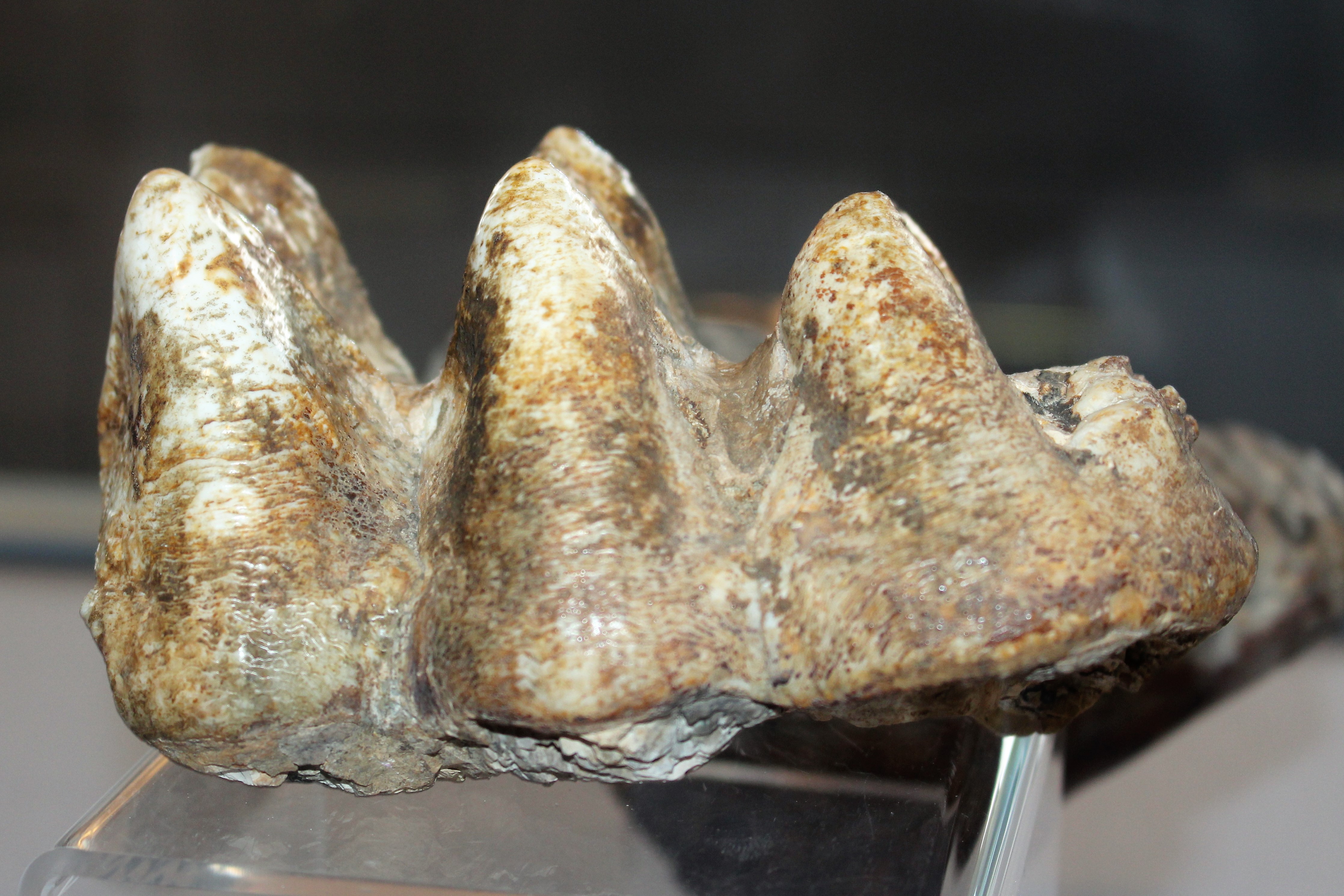|
Burning Tree Mastodon
The Burning Tree Mastodon site in Heath, Ohio, Heath, southern Licking County, Ohio, represents the location where the most complete skeleton of American mastodon was found. It is dated to about 11,500 BP. It is believed that there was human presence at the site at that time. Discovery The specimen was discovered on December 12, 1989 by a Flower Excavating Company drag line operator who was digging a new pond on the Burning Tree Golf Course grounds. The drag line’s shovel caught and damaged the skull. In the following three days, the fossil was excavated during relatively bitter winter cold and blowing winds. Excavation was conducted by the Ohio Historical Society and the Licking County Archaeology & Landmarks Society and volunteers from several organizations. Locality The locality was the grounds of the Burning Tree Golf Course, southern side of Ridgley Tract Road, just west of Lake Drive, south side of Heath, southern Licking County, central Ohio, United States. The American ... [...More Info...] [...Related Items...] OR: [Wikipedia] [Google] [Baidu] |
Mammut Americanum - Burning Tree Mastodon (Upper Pleistocene, 11
A mastodon, from Ancient Greek μαστός (''mastós''), meaning "breast", and ὀδούς (''odoús'') "tooth", is a member of the genus ''Mammut'' (German for 'mammoth'), which was endemic to North America and lived from the late Miocene to the early Holocene. Mastodons belong to the order Proboscidea, the same order as elephants and mammoths (which belong to the family Elephantidae). ''Mammut'' is the type genus of the extinct family Mammutidae, which diverged from the ancestors of modern elephants at least 27–25 million years ago, during the Oligocene. Like other members of Mammutidae, the molar (tooth), molar teeth of mastodons have zygodont morphology (where parallel pairs of cusp (anatomy), cusps are merged into sharp ridges), which strongly differ from those of elephantids. In comparison to its likely ancestor ''Zygolophodon'', ''Mammut'' is characterized by particularly long and upward curving upper tusks, reduced or absent tusks on the lower jaw, as well as th ... [...More Info...] [...Related Items...] OR: [Wikipedia] [Google] [Baidu] |
Heath, Ohio
Heath is a city in Licking County, Ohio, United States, and is located approximately 30 mi (48 km) east of Columbus. The population was 10,412 at the 2020 census. History This area is known to have been populated by the Hopewell Indians through the first century CE. They built large earthworks, including ancient burial mounds which are now preserved within Moundbuilders State Memorial on the north side of the city. This also has the Great Circle Earthwork, considered part of the Newark Earthworks, which has two other sections within the boundaries of nearby Newark, Ohio. The complex originally covered more than 3,000 acres, and was surveyed before 1850 by a team for the Smithsonian Institution. The -wide Newark Great Circle is one of the largest circular earthwork in the Americas, at least in construction effort. A deep moat is encompassed by walls that are high; at the entrance, the dimensions are even more grand. The Newark Earthworks is operated as a state ... [...More Info...] [...Related Items...] OR: [Wikipedia] [Google] [Baidu] |
Ohio
Ohio ( ) is a U.S. state, state in the Midwestern United States, Midwestern region of the United States. It borders Lake Erie to the north, Pennsylvania to the east, West Virginia to the southeast, Kentucky to the southwest, Indiana to the west, and Michigan to the northwest. Of the 50 List of states and territories of the United States, U.S. states, it is the List of U.S. states and territories by area, 34th-largest by area. With a population of nearly 11.9 million, Ohio is the List of U.S. states and territories by population, seventh-most populous and List of U.S. states and territories by population density, tenth-most densely populated state. Its List of capitals in the United States, capital and List of cities in Ohio, most populous city is Columbus, Ohio, Columbus, with the two other major Metropolitan statistical area, metropolitan centers being Cleveland and Cincinnati, alongside Dayton, Ohio, Dayton, Akron, Ohio, Akron, and Toledo, Ohio, Toledo. Ohio is nicknamed th ... [...More Info...] [...Related Items...] OR: [Wikipedia] [Google] [Baidu] |
Mastodon
A mastodon, from Ancient Greek μαστός (''mastós''), meaning "breast", and ὀδούς (''odoús'') "tooth", is a member of the genus ''Mammut'' (German for 'mammoth'), which was endemic to North America and lived from the late Miocene to the early Holocene. Mastodons belong to the order Proboscidea, the same order as elephants and mammoths (which belong to the family Elephantidae). ''Mammut'' is the type genus of the extinct family Mammutidae, which diverged from the ancestors of modern elephants at least 27–25 million years ago, during the Oligocene. Like other members of Mammutidae, the molar (tooth), molar teeth of mastodons have zygodont morphology (where parallel pairs of cusp (anatomy), cusps are merged into sharp ridges), which strongly differ from those of elephantids. In comparison to its likely ancestor ''Zygolophodon'', ''Mammut'' is characterized by particularly long and upward curving upper tusks, reduced or absent tusks on the lower jaw, as well a ... [...More Info...] [...Related Items...] OR: [Wikipedia] [Google] [Baidu] |
Burning Tree Mastodon Excavation Site, Burning Tree Golf Course
Combustion, or burning, is a high-temperature exothermic redox chemical reaction between a fuel (the reductant) and an oxidant, usually atmospheric oxygen, that produces oxidized, often gaseous products, in a mixture termed as smoke. Combustion does not always result in fire, because a flame is only visible when substances undergoing combustion vaporize, but when it does, a flame is a characteristic indicator of the reaction. While activation energy must be supplied to initiate combustion (e.g., using a lit match to light a fire), the heat from a flame may provide enough energy to make the reaction self-sustaining. The study of combustion is known as combustion science. Combustion is often a complicated sequence of elementary radical reactions. Solid fuels, such as wood and coal, first undergo endothermic pyrolysis to produce gaseous fuels whose combustion then supplies the heat required to produce more of them. Combustion is often hot enough that incandescent light in the fo ... [...More Info...] [...Related Items...] OR: [Wikipedia] [Google] [Baidu] |
Loxodonta Africana
The African bush elephant (''Loxodonta africana''), also known as the African savanna elephant, is a species of elephant native to sub-Saharan Africa. It is one of three extant elephant species and, along with the African forest elephant, one of two extant species of African elephant. It is the largest living terrestrial animal, with fully grown bulls reaching an average shoulder height of and a body mass of ; the largest recorded specimen had a shoulder height of and an estimated body mass of . The African bush elephant is characterised by its long prehensile Elephant trunk, trunk with two finger-like Process (anatomy), processes; a convex back; large ears which help reduce body heat; and sturdy tusks that are noticeably curved. The skin is grey with scanty hairs, and bending cracks which support thermoregulation by retaining water. The African bush elephant inhabits a variety of habitats such as forests, grasslands, woodlands, wetlands and agricultural land. It is a mixed ... [...More Info...] [...Related Items...] OR: [Wikipedia] [Google] [Baidu] |
Loxodonta Cyclotis
The African forest elephant (''Loxodonta cyclotis'') is one of the two living species of African elephant, along with the African bush elephant. It is native to humid tropical forests in West Africa and the Congo Basin. It is the smallest of the three living elephant species, reaching a shoulder height of . As with other African elephants, both sexes have straight, down-pointing tusks, which begin to grow once the animals reach 1–3 years old. The forest elephant lives in highly sociable family groups of up to 20 individuals. Since they forage primarily on leaves, seeds, fruit, and tree bark, they have often been referred to as the 'megagardener of the forest'; the species is one of many that contributes significantly to maintaining the composition, diversity and structure of the Guinean Forests of West Africa and the Congolese rainforests. Seeds of various plants will go through the elephant's digestive tract and eventually pass through in the animal's droppings (likely in a ne ... [...More Info...] [...Related Items...] OR: [Wikipedia] [Google] [Baidu] |
Elephas Maximus
''Elephas'' is a genus of elephants and one of two surviving genera in the family Elephantidae, comprising one extant species, the Asian elephant (''E. maximus''). Several extinct species have been identified as belonging to the genus, extending back to the Pliocene or possibly the late Miocene. Description Species of ''Elephas'' have distinct bossing of the parieto-occipital region of the skull. The premaxillae bones containing the tusks are tapered. Evolutionary history Relationships of living and extinct elephantids based on DNA, after Palkopoulou et al. 2018.Asian elephants share a closer common ancestry with mammoths (genus ''Mammuthus'') than they do with African elephants (''Loxodonta''). The oldest species attributed to the genus ''Elephas'' is ''E. nawataensis'' from the Late Miocene-Early Pliocene of Kenya, though the validity of this species and its relationship to ''Elephas'' has been doubted. The oldest species widely attributed to the genus, '' Elephas ekore ... [...More Info...] [...Related Items...] OR: [Wikipedia] [Google] [Baidu] |
Mastodons
A mastodon, from Ancient Greek μαστός (''mastós''), meaning "breast", and ὀδούς (''odoús'') "tooth", is a member of the genus ''Mammut'' (German for 'mammoth'), which was endemic to North America and lived from the late Miocene to the early Holocene. Mastodons belong to the order Proboscidea, the same order as elephants and mammoths (which belong to the family Elephantidae). ''Mammut'' is the type genus of the extinct family Mammutidae, which diverged from the ancestors of modern elephants at least 27–25 million years ago, during the Oligocene. Like other members of Mammutidae, the molar teeth of mastodons have zygodont morphology (where parallel pairs of cusps are merged into sharp ridges), which strongly differ from those of elephantids. In comparison to its likely ancestor '' Zygolophodon'', ''Mammut'' is characterized by particularly long and upward curving upper tusks, reduced or absent tusks on the lower jaw, as well as the shortening of the mandibu ... [...More Info...] [...Related Items...] OR: [Wikipedia] [Google] [Baidu] |
Archaeological Sites In Ohio
Archaeology or archeology is the study of human activity through the recovery and analysis of material culture. The archaeological record consists of Artifact (archaeology), artifacts, architecture, biofact (archaeology), biofacts or ecofacts, archaeological site, sites, and cultural landscapes. Archaeology can be considered both a social science and a branch of the humanities. It is usually considered an independent academic discipline, but may also be classified as part of anthropology (in North America – the four-field approach), history or geography. The discipline involves Survey (archaeology), surveying, Archaeological excavation, excavation, and eventually Post excavation, analysis of data collected, to learn more about the past. In broad scope, archaeology relies on cross-disciplinary research. Archaeologists study human prehistory and history, from the development of the first stone tools at Lomekwi in East Africa 3.3 million years ago up until recent decades. A ... [...More Info...] [...Related Items...] OR: [Wikipedia] [Google] [Baidu] |






